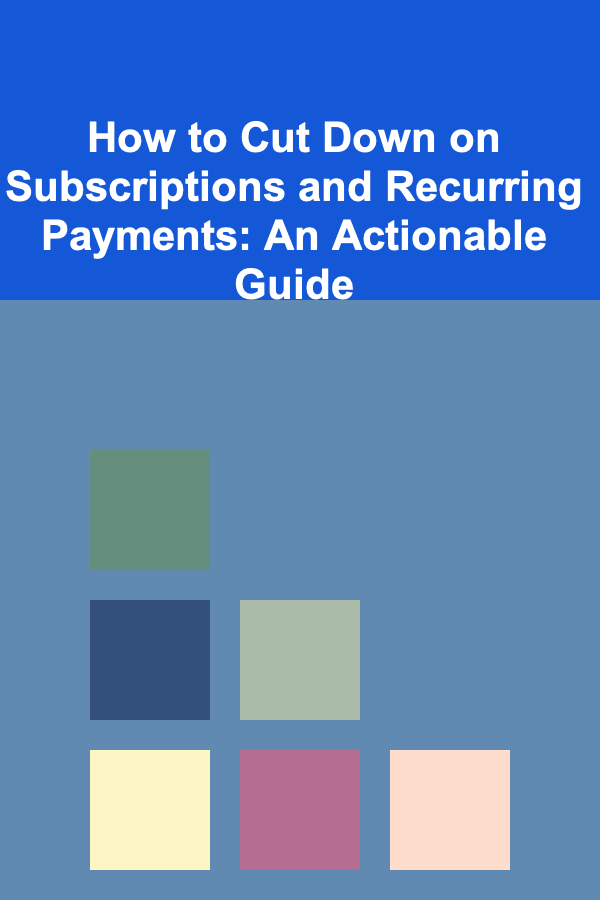
How to Cut Down on Subscriptions and Recurring Payments: An Actionable Guide
ebook include PDF & Audio bundle (Micro Guide)
$12.99$5.99
Limited Time Offer! Order within the next:

In today's digital age, subscriptions and recurring payments are everywhere---from streaming services to software tools, and even grocery deliveries. While these services can be convenient, they can also quickly add up, often without us realizing how much we're actually spending. Many people subscribe to services they don't use regularly, or even forget about subscriptions entirely. Cutting down on these payments can free up significant funds and simplify your financial life. In this guide, we'll explore actionable steps to help you reduce your subscriptions and recurring payments.
Audit Your Subscriptions
The first and most crucial step in cutting down on subscriptions is to get a clear picture of what you're actually paying for. Many of us forget about subscriptions or have multiple services for the same thing.
a. Identify All Subscriptions
Start by reviewing your bank statements and credit card bills. Look for recurring charges that you don't remember signing up for or haven't used in a while. It can be easy to forget a subscription for a service you used a few months ago but no longer need.
Use tools like Truebill or Trim to automatically track and categorize your subscriptions. These apps scan your bank and credit card transactions to identify recurring charges and can even help you cancel unwanted subscriptions.
b. Organize and Categorize Your Expenses
Once you've identified your subscriptions, group them by categories such as entertainment, software, lifestyle, fitness, etc. This will help you see where your money is going and where you can potentially make cuts. For instance, you may be subscribed to multiple streaming services like Netflix, Hulu, and Disney+, but you only watch one of them consistently.
c. Evaluate Subscription Frequency
Not all subscriptions need to be paid on a monthly basis. Some services offer annual subscriptions at a discounted rate, which might make sense for services you use regularly. For others, switching to a quarterly or annual plan can be a good way to save money in the long run.
Cancel Unused or Underused Subscriptions
Once you've completed your audit and have a better understanding of your subscriptions, it's time to make some cuts. Evaluate which subscriptions you're using and which ones have fallen by the wayside.
a. Cancel What You Don't Need
Be honest with yourself about what you're actually using. If you haven't used a particular service in a while, cancel it. Whether it's a magazine subscription, a fitness app you no longer use, or a streaming service you're only paying for out of habit---if it's not providing value to your life, it's time to let it go.
Some subscriptions may have an easy cancellation process, but others might require you to call customer service. Set aside some time to go through the cancellation processes for these subscriptions, and don't forget to confirm that you're no longer being charged.
b. Take Advantage of Free Trials
Free trials often convert into paid subscriptions if you forget to cancel them in time. To avoid this, set a reminder for the trial's expiration date. If you find the service useful, great; if not, cancel before you get charged.
c. Consider Downsizing or Downgrading
For services that you use regularly but don't need all the premium features of, consider downgrading to a cheaper plan. Many services offer tiered pricing models, and you may be able to save money by opting for a more basic plan that still meets your needs.
Consolidate Similar Services
Another effective way to cut down on recurring payments is to consolidate similar services. This means finding one service that provides the features you need, instead of paying for multiple ones.
a. Combine Streaming Services
If you have multiple streaming services, consider consolidating. Some services, like Disney+ and Hulu, offer bundles that give you access to multiple platforms at a discounted rate. You might also find that one streaming service covers most of your entertainment needs, eliminating the need for others.
Similarly, look for subscription bundles for software or digital tools. For example, Microsoft 365 offers Office apps, cloud storage, and email services in one package, which may be cheaper than subscribing to these tools separately.
b. Switch to All-in-One Tools
Many software tools, such as project management, productivity, or design apps, offer "all-in-one" versions that can replace several smaller subscriptions. For example, a service like Zapier can connect multiple apps you use and automate tasks, reducing the need for multiple standalone services. Similarly, a robust app like Notion can replace various productivity tools, including task management, note-taking, and project planning apps.
Negotiate or Switch Providers
When it comes to recurring payments, sometimes the best option isn't cancellation but negotiation. Many service providers offer discounts to retain customers or to encourage them to upgrade to annual plans.
a. Negotiate with Your Service Providers
Contact your service providers---whether it's your internet, phone, or streaming services---and ask if they can offer you a better deal. This can work especially well if you've been a loyal customer. Many companies are willing to offer a discount, waive fees, or extend promotional rates to retain you.
If you're on a month-to-month subscription, ask for a discount or consider switching to an annual plan for better rates. Service providers, especially in highly competitive industries like telecom or internet services, might offer you a lower rate to keep your business.
b. Look for Alternative Providers
Sometimes, the best way to save money is to switch providers altogether. Research alternative service providers that offer similar services at lower prices. For example, if your gym membership is too expensive, look for more affordable local gyms or try an online fitness platform. If your current streaming service has risen in price, see if other providers offer the same content for less.
c. Use Price Comparison Websites
Websites and tools that compare prices across multiple service providers can help you find better deals. For example, you can use Google Shopping , PriceGrabber , or Comparis to compare pricing across subscription-based services for everything from insurance to media subscriptions.
Automate Your Budgeting and Set Limits
To keep your subscriptions in check, it's helpful to automate your budgeting. This can ensure that you don't miss any unwanted charges and help you set financial boundaries for recurring payments.
a. Set Subscription Budgets
Incorporate your subscriptions into your overall budget by setting aside a certain amount for them each month. Knowing exactly how much you're willing to spend on subscriptions will prevent you from accidentally overspending. You can set limits for categories like entertainment, fitness, or software tools and stick to them.
b. Use Subscription Management Apps
Subscription management apps, like Bobby , Subby , or Truebill, can help you track your recurring payments and alert you when they are due or when rates increase. Many of these apps also provide a breakdown of all your subscriptions, making it easy to identify where you can cut back.
c. Set Up Alerts for Price Changes
Some subscriptions may increase their prices over time, and you might not notice until the new charge appears on your bill. Set up alerts for price changes to stay informed. Some apps allow you to track price changes for specific services and will notify you when a price hike happens.
Be Mindful of Future Subscriptions
Now that you've successfully reduced your subscriptions, it's important to avoid falling into the trap of signing up for unnecessary services in the future.
a. Think Before You Subscribe
Before committing to any new subscriptions, ask yourself: "Will I really use this service regularly? Does it provide enough value to justify the cost?" If the answer is no, consider whether a one-time purchase might be a better solution.
b. Use Free Alternatives
For many paid services, there are free alternatives that can meet your needs. For example, if you're paying for a premium photo-editing app, you might find that free tools like GIMP or Canva can offer similar features. For music streaming, consider using ad-supported services like Spotify Free or YouTube.
c. Set Subscription Reminders
If you do sign up for a service, set a reminder for yourself to reevaluate it after a few months. This will help ensure you're still getting value and can cancel it before the next payment is due.
Conclusion
Cutting down on subscriptions and recurring payments can significantly reduce your monthly expenses and simplify your financial life. Start by auditing your subscriptions, canceling unused services, and consolidating similar ones. Negotiate with providers or switch to cheaper alternatives, and don't forget to set a budget to keep track of your subscriptions in the future. By being mindful of your spending habits and regularly reevaluating your needs, you can gain more control over your finances and avoid unnecessary recurring charges.
Reading More From Our Other Websites
- [Home Soundproofing 101] How to Soundproof Floors: Effective Methods for a Quieter Home
- [Scrapbooking Tip 101] Best Eco‑Friendly Scrapbooking Materials for Sustainable Memory‑Keeping
- [Organization Tip 101] How to Store Seasonal Pet Supplies Effectively
- [Mindful Eating Tip 101] Mindful Eating and the Gut Microbiome: Emerging Evidence and Future Directions
- [Personal Investment 101] How to Apply Personal Finance Basics to Create Your First Investment Plan
- [Trail Running Tip 101] Nutrition Strategies for Ultra‑Long Trail Marathon Runs
- [Personal Care Tips 101] How to Prevent Teeth Sensitivity After Using Whitening Strips
- [Home Holiday Decoration 101] How to Create an Advent Calendar Decoration in Your Home
- [Home Party Planning 101] How to Secure Your Home for a Party: Home Party Safety Tips You Can't Ignore
- [Personal Investment 101] How to Interpret Economic Indicators for Investors: A Beginner's Guide to Market Forecasting

Create Passive Income by Offering Deep Learning Services
Read More
How to Combine Photography with Travel for a Fun and Commercially Viable Side Hustle
Read More
How to Ensure Your Home Security Devices Are Always Functioning Properly
Read More
How to Incorporate Shelves for Tool Organization
Read More
How To Understand the Cultural Context of a Language
Read More
How to Build Unshakeable Confidence
Read MoreOther Products

Create Passive Income by Offering Deep Learning Services
Read More
How to Combine Photography with Travel for a Fun and Commercially Viable Side Hustle
Read More
How to Ensure Your Home Security Devices Are Always Functioning Properly
Read More
How to Incorporate Shelves for Tool Organization
Read More
How To Understand the Cultural Context of a Language
Read More